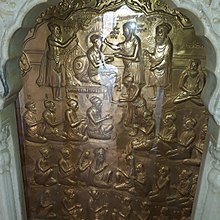
| Part of a series on |
| Sikhism |
|---|
 |
A Manji (Punjabi: ਮੰਜੀ ਪ੍ਰਥਾ ( Gurmukhi)) was a Sikh religious administrative unit, similar to a parish or diocese, for the propagation of Sikhism. [1] It was part of the Sikh missionary administrative organization founded by Guru Amar Das, the third Guru of Sikhism. [2]
Etymology
The word Manji or Manja literally means a cot (taken as the seat of authority in this context). [3] [2]
History
Origin
Guru Nanak would arrange early Sikh followers into various sangat congregations or parishes and instructed them to erect a dharamsal dedicated to spreading their Guru's message and teachings in their local area. [4]
Sangatia
Sangatia (also spelt as Sangtias) were head leaders from the local Sikh congregation (sangat) who arose as local leaders based upon personal piety and merit. [4] Anyone could arise to become a Sangatia as there was no established priestly or clergy-class in Sikhism, as long as they were well-learnt and dedicated enough to the religion. [4] Most dharamsals ceased being headed by a Sangatia after the introduction of the Manji and later Masand systems. [4] However, some remained under the leadership of a Sangatia due to the respect some earned. [4]
Establishment

Guru Amar Das divided the Sikh congregation areas into twenty-two Manji zones. [2] [5] He appointed a local preacher to be in-charge of each of the Manjis, known as a Manjidar. [4] For this purpose, a large group of 146 followers were trained for the propagation of Sikhism. 94 of them were men whilst 52 were women. [6] [7] [8] It had been conceptually similar in its aims to the diocese system in Christianity, and had been similarly important in Sikh missionary activity. [9] [3] It existed as a parallel system to the existing Mughal Empire and was modelled after the Mughal Empire's provincial zones, known as Subahs (of which there were also 22). [2] [5] Along with the Manjis, sub-centres known as Piris were established of which there were 52 in total. [10]
Purpose and role
The Manji system was established to give Sikhs a sense of their own sovereignty. [5] This is reflected by the fact that the number of zones established perfectly mimics the Mughal administrative system's zones, with both having twenty-two primary divisions. [5] The Manjis facilitated the spread of Sikhism to more faraway regions away from the already-established epicentres. [5]
Manjidars
Manjidars were appointed leaders under the purview of the Guru and were responsible for a specified Manji diocese or parish. [4] They were responsible for looking over the dharamsals and congregations of their assigned parish. [4] The main dharamsals located at localities founded by a Sikh guru or connected to their life were managed directly by a Sikh guru whilst the centres in more minor, obscure, or distant localities and areas were headed by an appointed Manjidar. [4] Positions of local Manjidars was not dynastic nor inheritable and it was not a professional duty as they still had to live the life of a householder. [4] They were not allowed to claim divine status for themselves. [4]
Manjidars should not be confused with the later Masands. [4]
See also
- Masand
- Piri system, a sub-system of the Sikh missionary system for women specifically
References
- ^ Manji: SIKH RELIGIOUS ADMINISTRATIVE UNIT, Encyclopædia Britannica
- ^
a
b
c
d Singh, Harjinder (12 September 2022).
"From Pothi to Guru Granth Sahib: The Perfect-Genius of Guru Arjan Sahib". Sikh Research Institute.
Manji is a raised bed or cot where the sovereign sits. Manji in the Sikh system of Raj already existed as the Sikh administrative unit. Guru Amardas Sahib started Manjis to parallel the Mughal empire.
- ^ a b DS Dhillon (1988). Sikhism Origin and Development. Atlantic Publishers. pp. 207–208.
- ^ a b c d e f g h i j k l Dhillon, Balwant Singh (November 1997). "Dharamsala: An Early Sikh Religious Centre". Institute of Sikh Studies.
- ^
a
b
c
d
e Singh, Pashaura; Mandair, Arvind-Pal Singh (2023). The Sikh World. Routledge Worlds. Taylor & Francis.
ISBN
9780429848384.
Guru Amar Das created the institution of manjis ("Cots," seats of authority) for attracting new followers, each headed by men and women of good standing in the Sikh community and helping in the dissemination of the Guru's word in the distant communities. ... Proclaiming a parallel notion of sovereignty Guru Amar Das organized the Panth into 22 administrative units (manjis), reflecting the number of provinces into which the Mughal empire was divided.
-
^ Chawla, A.S.; Singh, Dharminder; Kaur, Jasleen. "7.2 - Established the Sikh Administration System". Management Perspectives of Sikh Religion.
Guru Amar Das established the Manji System to propagate Sikhism in a logical and planned way. He divided Sikh congregation areas into 22 Manjis and a local preacher was made in-charge of each Manji. He trained the group of 146 followers, out of which 52 were women, to attend to the spiritual needs of the people. He also appointed preachers called Masands, who went across the country to spread the gospel of Sikhism.
- ^ William Owen Cole; Piara Singh Sambhi (1995). The Sikhs: Their Religious Beliefs and Practices. Sussex Academic Press. pp. 20–21. ISBN 978-1-898723-13-4.
- ^ Louis E. Fenech; W. H. McLeod (2014). Historical Dictionary of Sikhism. Rowman & Littlefield. pp. 29–30. ISBN 978-1-4422-3601-1.
- ^ Alon Goshen-Gottstein (2016). The Future of Religious Leadership: World Religions in Conversation. Lexington. p. 109. ISBN 978-1-4985-4025-4.
-
^ Jain, Harish (2003). The Making of Punjab. Unistar Books. p. 273.
After attaining the Guru's mantle, he [Guru Amar Das] visited various places to propagate the message of the faith. He reorganised the Sikh faith and established 22 centres, each called a 'manji', and 52 sub-centres, each called a 'peehri' for this purpose.